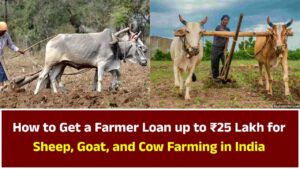How to Get a Farmer Loan up to ₹25 Lakh for Sheep, Goat, and Cow Farming in India
1. National Livestock Mission (NLM) – Entrepreneurship Scheme
- Subsidy Structure: Under NLM’s Entrepreneurship Scheme, subsidies are offered for establishing sheep and goat breeding units based on the number of animals. For instance:
- 100 female + 5 male: subsidy up to ₹10 lakh
- 200 + 10: subsidy up to ₹20 lakh
- Up to 500 + 25: subsidy up to ₹50 lakh
- How to Apply:
- Register on the NLM portal (e.g., via Udyamimitra).
- Upload your project proposal (DPR) and required documents.
- State Implementing Agency reviews and forwards it for bank sanction.

2. Financing & Loan Schemes
a) IDBI Bank – Sheep & Goat Rearing Loan
- Offers ₹50,000 to ₹50 lakh.
- Margin:
- Up to ₹1 lakh: no margin.
- Above ₹1 lakh: 15–25%.
- Security:
- Up to ₹1 lakh: asset hypothecation.
- Above ₹1 lakh: hypothecation + land mortgage.
- Repayment: Typically within 4–5 years (goats) or 5 years (sheep), often via progeny sales.
- Requires a local animal husbandry department recommendation.
b) MUDRA Loans (PMMY)
- Specifically for non-farm activities; goat farming generally not eligible.
- Still, some farm-linked small enterprises can access up to ₹10 lakh under Tarun category.
- Shishu: up to ₹50,000 (primary).
- Kishor: ₹50,001–5 lakh.
- Tarun: ₹5–10 lakh.
- Collateral-free up to ₹1.6 lakh; special subsidies for women or marginalized categories.
c) Priority Sector Lending
- Banks must extend credit for agriculture and allied activities up to ₹20 lakh under priority sector lending rules.
- This aggregate limit can include loans for livestock as well.
d) Other Support: Livestock Infrastructure & Insurance
Related Posts
- NLM also offers capital subsidies up to 50% for goat/sheep farms along with interest subvention via AHIDF (Animal Husbandry Infrastructure Development Fund)—typically around 3% interest subvention.
- Animal insurance is available under state AHD or NLM-backed livestock insurance schemes.
3. Collateral-Free, Group-Based Credit
If you’re a small or marginal farmer without collateral:
- Joint Liability Groups (JLGs) allow members to borrow based on group guarantee, not requiring land ownership.
- Credit Guarantee Fund Trust for MSMEs (CGTMSE) provides collateral-free credit guarantees up to ₹5 crore for eligible enterprises (which could include farming entrepreneurs if registered as MSMEs).
4. State-Level Initiatives (e.g., Karnataka, Telangana)
- Karnataka: Emphasizes veterinary infrastructure, regular vaccination, and urges banks to extend loan support for livestock farming.
- Telangana: Offers sheep distribution with 75% subsidized cost, insurance, and fodder support for traditional shepherd communities.
5. Summary Table
| Scheme / Source | Loan/Subsidy Range | Highlights & Notes |
|---|---|---|
| NLM Entrepreneurship | Subsidy ₹10–50 lakh | Based on unit size and animal count; register online via NLM |
| IDBI Livestock Loan | ₹0.5 lakh – ₹50 lakh | Structured financing with margin and collateral requirements |
| MUDRA PMMY (Tarun) | Up to ₹10 lakh | Best suited for allied non-farm activities; some overlaps |
| NLM + AHIDF | 50% subsidy + 3% subvention | Reduced project cost + lower interest |
| Priority Sector Lending | Up to ₹20 lakh | Broad umbrella credit for agriculture and allied sectors |
| JLG / CGTMSE | Collateral-free via groups | Good for small farmers; CGTMSE broadens eligibility |
| State Programs (e.g., Karnataka, Telangana) | Varies | Insurances, distribution, support aligned to local farming |
6. Suggested Next Steps
- Define your project scale – how many animals, infrastructure, budget.
- Apply via NLM portal to claim subsidy, and combine with loan.
- Approach banks (IDBI, nationalized banks, cooperatives) for term loan under priority sector or JLG model if capital insufficient.
- Explore CGTMSE-backed credit if structured as an MSME or livestock enterprise.
- Consult local govt agencies (Animal Husbandry Department, NABARD office, KVK) for guidance on state-specific support and deriving the best mix of subsidy + loan.
Would you like me to help draft a sample project report (DPR) for, say, a ₹25 lakh goat/sheep farming unit? That could include cost breakdown, income projections, and repayment plans—really handy for loan applications. Just let me know your preferred scale or animal type!
